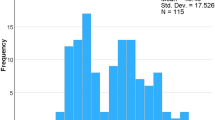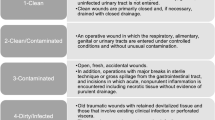Abstract
Purpose
Necrotising soft-tissue infections (NSTI) are characterised by necrosis, fast progression, and high rates of morbidity and mortality, but our knowledge is primarily derived from small prospective studies and retrospective studies.
Methods
We performed an international, multicentre, prospective cohort study of adults with NSTI describing patient’s characteristics and associations between baseline variables and microbiological findings, amputation, and 90-day mortality.
Results
We included 409 patients with NSTI; 402 were admitted to the ICU. Cardiovascular disease [169 patients (41%)] and diabetes [98 (24%)] were the most common comorbidities; 122 patients (30%) had no comorbidity. Before surgery, bruising of the skin [210 patients (51%)] and pain requiring opioids [172 (42%)] were common. The sites most commonly affected were the abdomen/ano-genital area [140 patients (34%)] and lower extremities [126 (31%)]. Monomicrobial infection was seen in 179 patients (44%). NSTI of the upper or lower extremities was associated with monomicrobial group A streptococcus (GAS) infection, and NSTI located to the abdomen/ano-genital area was associated with polymicrobial infection. Septic shock [202 patients (50%)] and acute kidney injury [82 (20%)] were common. Amputation occurred in 22% of patients with NSTI of an extremity and was associated with higher lactate level. All-cause 90-day mortality was 18% (95% CI 14–22); age and higher lactate levels were associated with increased mortality and GAS aetiology with decreased mortality.
Conclusions
Patients with NSTI were heterogeneous regarding co-morbidities, initial symptoms, infectious localisation, and microbiological findings. Higher age and lactate levels were associated with increased mortality, and GAS infection with decreased mortality.



Similar content being viewed by others
References
Stevens DL, Bryant AE (2017) Necrotizing soft-tissue infections. N Engl J Med 377:2253–2265
Sartelli M, Guirao X, Hardcastle TC et al (2018) 2018 WSES/SIS-E consensus conference: recommendations for the management of skin and soft-tissue infections. World J Emerg Surg 13:58
Hua C, Sbidian E, Hemery F et al (2015) Prognostic factors in necrotizing soft-tissue infections (NSTI): a cohort study. J Am Acad Dermatol 73:1006–12.e8
Hakkarainen TW, Burkette Ikebata N, Bulger E, Evans HL (2014) Moving beyond survival as a measure of success: understanding the patient experience of necrotizing soft-tissue infections. J Surg Res 192:143–149
Soltani AM, Best MJ, Francis CS, et al (2014) Trends in the incidence and treatment of necrotizing soft tissue infections: an analysis of the national hospital discharge survey. J Burn Care Res 1–6
Stevens DL, Bisno AL, Chambers HF et al (2014) Practice guidelines for the diagnosis and management of skin and soft tissue infections: 2014 update by the infectious diseases society of America. Clin Infect Dis 59:147–159
Wong C-H, Khin L-W, Heng K-S et al (2004) The LRINEC (Laboratory Risk Indicator for Necrotizing Fasciitis) score: a tool for distinguishing necrotizing fasciitis from other soft tissue infections. Crit Care Med 32:1535–1541
Fernando SM, Tran A, Cheng W et al (2019) Necrotizing soft tissue infection: diagnostic accuracy of physical examination, imaging, and LRINEC score: a systematic review and meta-analysis. Ann Surg 269:58–65
Madsen MB, Skrede S, Bruun T et al (2018) Necrotizing soft tissue infections—a multicentre, prospective observational study (INFECT): protocol and statistical analysis plan. Acta Anaesthesiol Scand 62:272–279
Improving Outcome of Necrotizing Fasciitis: Elucidation of complex host and pathogen signatures that dictate severity of tissue infection. https://cordis.europa.eu/project/rcn/106297/factsheet/en. Accessed 25 Mar 2019
von Elm E, Altman DG, Egger M et al (2007) The strengthening the reporting of observational studies in epidemiology (STROBE) statement: guidelines for reporting observational studies. Lancet (London, England) 370:1453–1457
May AK (2009) Skin and soft tissue infections. Surg Clin North Am 89:403–420
Bulger EM, Maier RV, Sperry J et al (2014) A novel drug for treatment of necrotizing soft-tissue infections: a randomized clinical trial. JAMA Surg 149:528
Govindan S, Prescott HC, Chopra V, Iwashyna TJ (2018) Sample size implications of mortality definitions in sepsis: a retrospective cohort study. Trials 19:198
Kao LS, Lew DF, Arab SN et al (2011) Local variations in the epidemiology, microbiology, and outcome of necrotizing soft-tissue infections: a multicenter study. Am J Surg 202:139–145
Proud D, Bruscino Raiola F, Holden D, et al (2014) Are we getting necrotizing soft tissue infections right? A 10-year review. ANZ J Surg 84
Chen I-C, Li W-C, Hong Y-C et al (2011) The microbiological profile and presence of bloodstream infection influence mortality rates in necrotizing fasciitis. Crit Care 15:R152
Das DK, Baker MG, Venugopal K (2012) Risk factors, microbiological findings and outcomes of necrotizing fasciitis in New Zealand: a retrospective chart review. BMC Infect Dis 12:348
Darenberg J, Luca-Harari B, Jasir A et al (2007) Molecular and clinical characteristics of invasive group A streptococcal infection in Sweden. Clin Infect Dis 45:450–458
Lin J-N, Chang L-L, Lai C-H et al (2013) Group A streptococcal necrotizing fasciitis in the emergency department. J Emerg Med 45:781–788
Bruun T, Kittang BR, de Hoog BJ et al (2013) Necrotizing soft tissue infections caused by Streptococcus pyogenes and Streptococcus dysgalactiae subsp. equisimilis of groups C and G in western Norway. Clin Microbiol Infect 19:E545–E550
Anaya DA, McMahon K, Nathens AB et al (2005) Predictors of mortality and limb loss in necrotizing soft tissue infections. Arch Surg 140:151–157
Singer M, Deutschman CS, Seymour CW et al (2016) The third international consensus definitions for sepsis and septic shock (Sepsis-3). JAMA 315:801
Arif N, Yousfi S, Vinnard C (2016) Deaths from necrotizing fasciitis in the United States, 2003–2013. Epidemiol Infect 144:1338–1344
Beck MK, Jensen AB, Nielsen AB et al (2016) Diagnosis trajectories of prior multi-morbidity predict sepsis mortality. Sci Rep 6:36624
de Prost N, Sbidian E, Chosidow O et al (2015) Management of necrotizing soft tissue infections in the intensive care unit: results of an international survey. Intensive Care Med 41:1506–1508
Madsen MB, Hjortrup PB, Hansen MB et al (2017) Immunoglobulin G for patients with necrotising soft tissue infection (INSTINCT): a randomised, blinded, placebo-controlled trial. Intensive Care Med 43:1585–1593
Boyer A, Vargas F, Coste F et al (2009) Influence of surgical treatment timing on mortality from necrotizing soft tissue infections requiring intensive care management. Intensive Care Med 35:847–853
Bechar J, Sepehripour S, Hardwicke J, Filobbos G (2017) Laboratory risk indicator for necrotising fasciitis (LRINEC) score for the assessment of early necrotising fasciitis: a systematic review of the literature. Ann R Coll Surg Engl 99:341–346
Le Gall JR, Lemeshow S, Saulnier F (1993) A new simplified acute physiology score (SAPS II) based on a European/North American multicenter study. JAMA 270:2957–2963
Kellum JA, Lameire N (2013) Diagnosis, evaluation, and management of acute kidney injury: a KDIGO summary (Part 1). Crit Care 17:204
Bellomo R, Ronco C, Kellum JA et al (2004) Acute renal failure—definition, outcome measures, animal models, fluid therapy and information technology needs: the second international consensus conference of the acute dialysis quality initiative (ADQI) group. Crit Care 8:R204–R212
Wallace AB (1951) The exposure treatment of burns. Lancet 257:501–504
Vincent JL, Moreno R, Takala J et al (1996) The SOFA (Sepsis-related Organ Failure Assessment) score to describe organ dysfunction/failure. On behalf of the working group on sepsis-related problems of the European society of intensive care medicine. Intensive Care Med 22:707–710
Acknowledgements
The INFECT study group includes: Daniel Bidstrup, Nina F. Bærnthsen, Gladis H. Frendø, Erik C. Jansen, Lærke B. Madsen, Rasmus B. Müller, Emilie M. J. Pedersen, Marie W. Petersen: http://orcid.org/0000-0003-1127-9599, Frederikke Ravn, Isabel F. G. Smidt-Nielsen, Anna M. Wahl, Sandra Wulffeld, Sara Aronsson, Anders Rosemar, Joakim Trogen, Torbjørn Nedrebø, Oddvar Oppegaard, Eivind Rath, and Marianne Sævik. Author affiliations are given in the ESM.
This work is part of the INFECT programme, supported by the European Union’s Seventh Framework Programme under the Grant agreement 305340. We are grateful to patients and relatives for their consent to participate, and to the clinical staff and research staff at the study sites for their important contributions.
Author information
Authors and Affiliations
Consortia
Contributions
SS, AP, ECJ, TB, ANT, and OH contributed to the conception and the design of the study. MBM, SS, PA, MN, TB, MBH, PP, MH, AR, DB, NFB, GHF, LBM, RM, EMJP, FR, IFGSM, AMW, SW, SA, JT, TN, OO, and ER were involved in the acquisition of data. MBM, SS, AP, TB, ES, FB, VAPMS, ANT, and OH contributed to analysis or interpretation of data or both. MBM, AP, and OH were involved in drafting the manuscript. MBM, SS, AP, MN, TB, MBH, AR, ES, VAPMS, NFB, OO, ER, ANT, and OH critically revised the manuscript. All authors approved the final version for submission.
Corresponding author
Ethics declarations
Conflicts of interest
The Department of Intensive Care, Rigshospitalet, has received research funds from CSL Behring, Switzerland, Fresenius Kabi, Germany, and Ferring Pharmaceuticals, Denmark.
Additional information
Publisher's Note
Springer Nature remains neutral with regard to jurisdictional claims in published maps and institutional affiliations.
Electronic supplementary material
Below is the link to the electronic supplementary material.
Rights and permissions
About this article
Cite this article
Madsen, M.B., Skrede, S., Perner, A. et al. Patient’s characteristics and outcomes in necrotising soft-tissue infections: results from a Scandinavian, multicentre, prospective cohort study. Intensive Care Med 45, 1241–1251 (2019). https://doi.org/10.1007/s00134-019-05730-x
Received:
Accepted:
Published:
Issue Date:
DOI: https://doi.org/10.1007/s00134-019-05730-x




